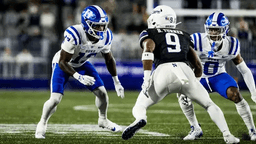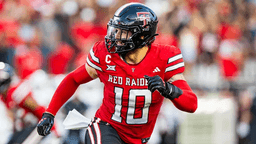Hurricanes restock the prospect cupboard with international flavor
Carolina Hurricanes select 10 prospects in 2024 NHL Draft
By: Draft Carolina · 1y

Photo: Canes Country
The Carolina Hurricanes have been masters of keeping a championship window open while still maintaining a healthy prospect pool. Recently departed General Manager Don Waddell shrewdly made deals to bring in veterans to help the parent club pursue a Stanley Cup without significantly depleting their deep prospect ranks. At the annual NHL Draft, Waddell would maneuver up and down the draft board swapping picks to simultaneously procure players that his scouts valued and adding additional picks in both current and future drafts. It has been an effective strategy that has relied heavily on selecting players from Europe and Russia.
European prospects often play against competitors that are older and more physically mature. This advanced level of competition is an excellent way to develop prospects for the long season that quickly grinds down the unprepared. The other benefit to NHL teams is that they have four years to sign European prospects to Entry Level Contracts (ELC), as opposed to the two requirement for draft picks coming out of the Canadian Hockey League. The two years of additional evaluation allows teams to better identify players who could successfully complete an ELC. This is important because NHL teams are only permitted to have 50 players under NHL contract and removing guesswork from the process increases the likelihood of maximum production from those 50 contracts.
Carolina has been unafraid to reach into the Russian Hockey Federation (RHF) to draft players. Due to geopolitical concerns and contracts that can be intricate in Russia, it can be difficult for young Russian players to ever make it to North America to pursue their NHL dreams. Recently that door of hope has been opened slightly and Russian players are beginning to trickle back into NHL organizations. With Russian players, teams can be extremely patient. There is no transfer agreement between The International Ice Hockey Federation (IIHF) and the RHF. Therefore, there is no time limit on when a prospect must be signed by a team before his rights are relinquished.
While Waddell was constructing his prospect model, his Assistant General Manager Eric Tulsky was a keen observer. When Waddell resigned to become general manager of the Columbus Blue Jackets, Tulsky was up to speed and ready to execute the successful draft playbook. As the team’s new general manager, he did not miss a step once the draft arrived. By the time the process was concluded, Tulsky had made a handful of maneuvers and left the Las Vegas draft with 10 new players that he hopes are contributors down the road. Of the 10 new Baby Canes, nine hailed from Europe or Russia. He selected only one player from the Canadian Hockey League junior ranks.
Tulsky wasted no time implementing his strategy. The Hurricanes entered the draft with the 27th overall selection in the first round. When the 27th pick rolled around, he traded it to the Chicago Black Hawks for two second round picks, giving him three total in that pivotal round. With those two new picks, Tulsky selected Czech defenseman Dominik Badinka 34th overall and Russian left winger Nikita Artamonov 50th overall. Badinka was considered a possible first round pick. He is a coveted right handed shot with size at 6-foot-3 and 190 pounds. He benefits from playing for Malmo in Sweden’s highest level of play, the Elite League. Artamonov also was a boy playing against men in Russia’s Kontinental Hockey League (KHL). He is smart and plays a consistent game night in and night out. Scouts believe if he were not playing in Russia, he would have been a first-round pick.
Tulsky traded his own second round pick, 60th overall, to his old friend Waddell, for a third-round pick, 69th overall, and a fifth-round pick, 133rd overall. He used the pick from the Blue Jackets to stay on script by taking a Swedish defenseman, Noel Fransen. Fransen scored 44 points in 45 games in Sweden’s junior tier program. It is encouraging sign for a Swedish defenseman to average nearly a point a game. Later in round three he once again did business with the Black Hawks by sending the 92nd pick in exchange for a 2025 third-round pick. Considering the rebuilding process the Black Hawks are in, that pick figures to be higher than 92nd next year.
Things began to calm down for Carolina in the fourth round. There were no picks traded that round and the Hurricanes went back to Russia, this time for a defenseman, Alexander Siryatsky, a lanky 6-foot-2, 159 pounder who played in Russia’s junior league the MHL. Siryatsky is considered a solid two-way player that reads and reacts quickly to the game flow. He will remain in Russia for multiple years to get stronger. The Hurricanes are hopeful he will log significant time in the KHL next season.
The second pick acquired from Columbus was used to obtain, stop me if you have heard this before, a prospect from Sweden, left winger Oskar Vuollet. He was fifth in the Swedish junior league scoring with 29 goals and 61 points for Skelleftea. What caught scouts’ eyes was his playoff production of 14 goals and 21 points in nine playoff games. He displayed the speed and touch to be one of the first European draftees to make the move to North America and the small rinks. His floor is a middle six forward. The Hurricanes own fifth round pick was used to draft the only Canadian player, left winger Justin Poirier from Baie-Comeau of the QMJHL. His draft stack may have suffered from his size, 5-foot-8 and 173 pounds. The fact that he was the first 17-year old since a guy named Crosby to score 50 goals in a season in the QMJHL will get him a long look from the organization. At a minimum, he should enjoy a long career in the American Hockey League.
Picks in the sixth and seventh rounds are akin to lottery scratch off tickets. Organizations are euphoric if the minimal investment yields a jackpot. If underneath the ticket coating is a bunch of non-matching numbers and an apology, teams shrug their shoulders and go about their day. The Hurricanes purchased four Russian lottery tickets with their final selections. They drafted defenseman Timur Kol 168th overall, defenseman Roman Shokhrin 184th overall, left winger Fydor Avramov 188th overall, and left wing Andrey Krutov 220th overall. All four prospects played last season in the MHL. If any of them spends significant time in North America, it will be a bonus. Chances are that the Hurricanes will either allow their rights to expire or they will be part of a future transaction for more assets.
Assessing the success of an NHL draft is the hardest of the four major North American sports. Trying to gauge how teenagers will navigate the three to four year development journey to the NHL is a crapshoot at best. Multiple factors can derail a promising career such as immaturity, difficulty adapting to cultural and geographic changes, or physical and mental plateaus. The deeper a prospect is selected int the draft, the odds of failure increase exponentially. The Hurricanes have adopted the philosophy that more throws at the dart board increases the chances of a bullseye. The evidence to date supports that view and nothing about this draft class indicates a deviation from continued success.





Comments:
Log in or sign up to read and post comments.